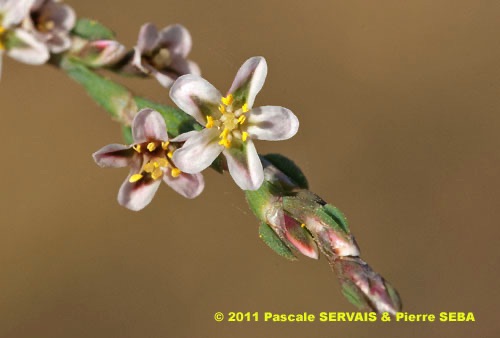
Polygonum scoparium Req. ex Loisel.
Fam. : Polygonaceae
© Pascale SERVAIS & Pierre SEBA, 2018. Tilo Botanica: Flore de Tilos et du Dodécanèse / Flora of Tilos and of the Dodecanese
English translation by Brenda Bradbury, Howard Bradbury and Stéphane Léonard
Plante herbacée, ligneuse à la base, à tiges étalées à prostrées, ramifiées, glabres, cylindriques, longues, raides, finement striées, de 2,5 à 7 mm de diamètre, non feuillées jusqu’au sommet.
Feuilles presque toutes avortées, alternes, simples, elliptiques, étroites, entières mais dentées au sommet, glabres, de 20 à 60 mm de long, fanées à la floraison, à gaine membraneuse blanche (ochréa) de 3 à 4 mm de long, embrassant la tige et plus courte que les entre-nœuds.
Fleurs à symétrie radiaire, blanc rose taché de vert, de 2 à 4 mm de diamètre, portées par un court pédoncule rougeâtre, réunies en bouquets par 1 à 3 à l’aisselle de très courtes bractées. Périanthe à 5 tépales soudés à la base. Souvent 8 étamines à filet blanc et à anthère jaune. 3 styles. Ovaire supère.
Fruits, akènes non ailés, noirâtres, très luisants, de 2 à 5 mm, égalant le périanthe.
___________________________
Plant herbaceous, woody at the base. Stems spread out to prostrate, branched, glabrous, cylindrical, long, stiff, covered in thin ridges, from 2.5 to 7 mm in diameter, nonleafy up to the top.
Leaves almost all aborted, alternate, simple, elliptic, narrow, entire but toothed at the top, glabrous, from 20 to 60 mm long, faded at flowering, with a white membranous sheath (ochrea) from 3 to 4 mm long, clasping the stem and shorter than the internodes.
Flowers radially symmetrical, pink white, with green marks, from 2 to 4 mm in diameter, carried by a short reddish peduncle, joined together in clusters by 1 to 3 at the axil of very short bracts. Perianth with 5 partly fused tepals. Often 8 stamens with a white filament and a yellow anther. 3 styles. Ovary superior.
Fruits, nonwinged, blackish, very shiny achenes, from 2 to 5 mm, equalling the perianth.
Descripteurs / Identifying features
1
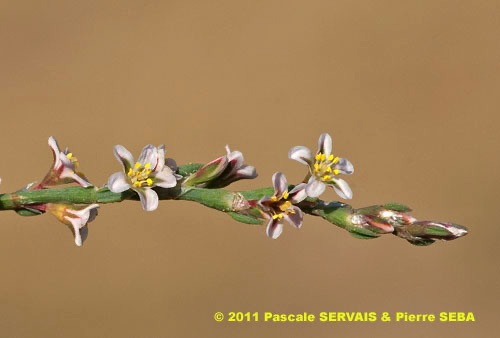
2
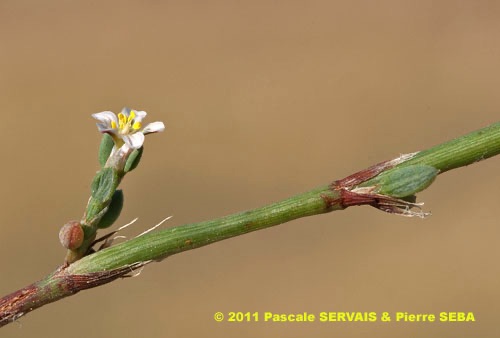
3
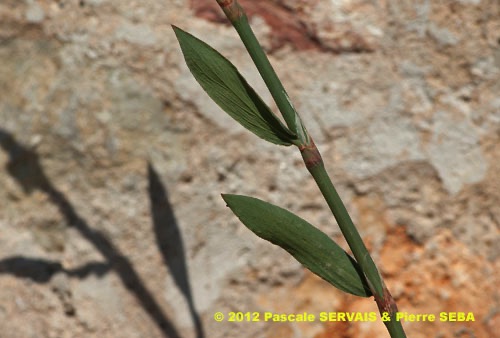
4
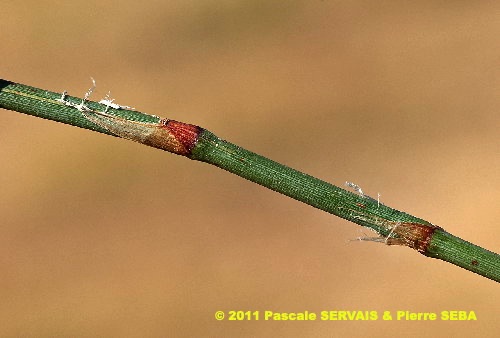
5
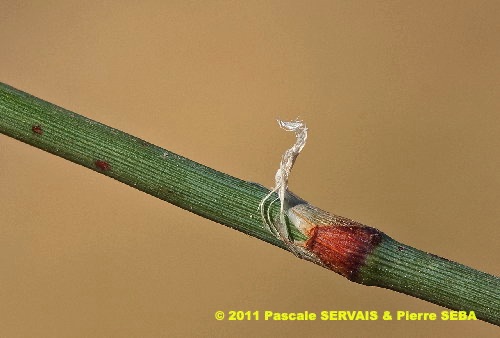
6
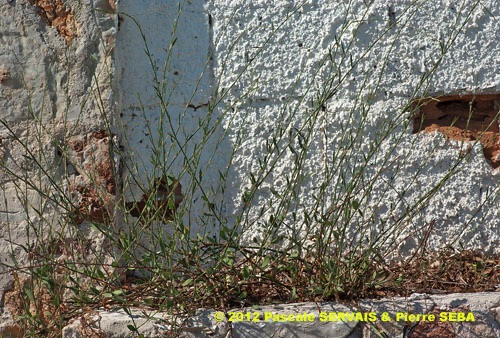
7
Étymologie / Etymology :
Polygonum : emprunt du latin polygonus, -i (nom) = la renouée, nom
donné à la plante par Pline, naturaliste latin mort en 79 apr. J.-C.,
forme latinisée du grec ancien πολύγονον, -ου (nom)
[ < πολύς, πολλή, πολύ (adj.) = beaucoup + γόνος, -ου (nom)
= l’enfant, la descendance ] = qui a une nombreuse descendance, très
fécond, nom donné à la plante par Dioscoride, médecin et botaniste
grec mort en 90 apr. J.-C., en référence à l’abondance de ses graines.
OU
emprunt du grec ancien πολύς, πολλή, πολύ (adj.) = beaucoup
+ γόνυ, γόνατος (nom) = le genou, l’articulation, le nœud d’une tige,
en référence à ses tiges très noueuses.
Scoparium : emprunt du latin scoparius, -a, -um (adj.)
[ < scopa, -ae (nom) = le balai ] = qui concerne les balais, en forme de
balai, en référence à son ancienne utilisation dans la fabrication
des balais.
Polygonum : borrowed from Latin polygonus, -i (noun) = knotweed, name
given to the plant by Plinius, Latin naturalist died in 79 AD, Latinized
form of the Classical Greek πολύγονον, -ου (noun)
[ < πολύς, πολλή, πολύ (adj) = beaucoup + γόνος, -ου (noun)
= child, descendant ] = which has many descendants, very fruitful,
name given to the plant by Dioscorides, Greek doctor and botanist died
in 90 AD, referring to the abundance of seeds.
OR
borrowed from Classical Greek πολύς, πολλή, πολύ (adj) = many
+ γόνυ, γόνατος (noun) = knee, joint, node of stalk, referring to its
nodose stems.
Scoparium : borrowed from Latin scoparius, -a, -um (adj)
[ < scopa, -ae (noun) = broom ] = which relates to the broom,
broom-shaped, referring to its old use in the manufacturing of brooms.
Synonymes / Synonyms :
Polygonum equisetiforme Gren. & Godr.
Polygonum corsicanum Link
Polygonum equisetiforme subsp. scoparium. (Req. ex Loisel.) Arcang.
Noms vernaculaires / Common names :
Nom français / French name :
Renouée à balais.
Nom anglais / English name :
Horsetail knotweed.
Nom allemand / German name :
Schachtelhalm-Knöterich.
Nom italien / Italian name :
Poligono scopario.
Habitat :
Cultures - Lieux pierreux - Lieux incultes - Chemins.
Cultivated places - Stony places - Waste ground - Waysides.
Île / Island :
Tilos.
Hauteur / Height range :
De 5 cm à 20 cm.
From 5 cm to 20 cm.
Floraison / Flowering time :
De mai à octobre.
From May to October.
Groupe / Classification :
Dicotylédones.
Dicotyledons.
Pérennité / Lifespan :
Vivace.
Perennial.
Description :
Clés dichotomiques et descripteurs distinctifs des 2 espèces / Dichotomous keys and distinctive identifying features of the 2 species
Photo 1 :
Localisation / Location : Tilos, Livadia, Aghios Stephanos
Date : 04/10/2011
GPS : Lat. 36,41015° N / Long. 27,39405° E / Alt. 2 m
Type : Photographie numérique / Digital Photograph (10 mégapixels)
Photo 2 :
Localisation / Location : Tilos, Livadia, Aghios Stephanos
Date : 04/10/2011
GPS : Lat. 36,41015° N / Long. 27,39405° E / Alt. 2 m
Type : Photographie numérique / Digital Photograph (10 mégapixels)
Photo 3 :
Localisation / Location : Tilos, Livadia, Aghios Stephanos
Date : 04/10/2011
GPS : Lat. 36,41015° N / Long. 27,39405° E / Alt. 2 m
Type : Photographie numérique / Digital Photograph (10 mégapixels)
Photo 4 :
Localisation / Location : Tilos, Livadia, Aghios Stephanos
Date : 03/06/2012
GPS : Lat. 36,41015° N / Long. 27,39405° E / Alt. 2 m
Type : Photographie numérique / Digital Photograph (10 mégapixels)
Photo 5 :
Localisation / Location : Tilos, Livadia, Aghios Stephanos
Date : 04/10/2011
GPS : Lat. 36,41015° N / Long. 27,39405° E / Alt. 2 m
Type : Photographie numérique / Digital Photograph (10 mégapixels)
Photo 6 :
Localisation / Location : Tilos, Livadia, Aghios Stephanos
Date : 04/10/2011
GPS : Lat. 36,41015° N / Long. 27,39405° E / Alt. 2 m
Type : Photographie numérique / Digital Photograph (10 mégapixels)
Photo 7 :
Localisation / Location : Tilos, Livadia, Aghios Stephanos
Date : 03/06/2012
GPS : Lat. 36,41015° N / Long. 27,39405° E / Alt. 2 m
Type : Photographie numérique / Digital Photograph (10 mégapixels)

Google Maps
Google Maps
Google Maps
Google Maps
Google Maps
Google Maps
Google Maps